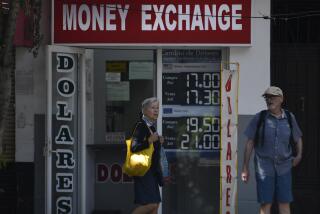Doing Business : Trying to Keep Up With an Economy Gone Loco : American Express’ manager in Buenos Aires marshals his troops for battle every time hyper-inflation attacks. When the cost of money hits 1% an hour, it can be, as he puts it, ‘rather dramatic.’
- Share via
BUENOS AIRES — When hyper-inflation descends on Argentina, Mark Kirn assembles his 30 top aides in a conference room in the new 10-story American Express headquarters and prepares for battle.
“It becomes a command post, like a war post for us. We stick papers on the walls and put decisions there. We move very, very quickly, all day long and weekends,” he said. “When the cost of money hits 1% an hour, which we hit sometime in February, and you say, ‘I’m going to borrow funds for 24 hours and it’s going to cost 25% interest,’ then it’s rather dramatic.”
No wonder Kirn resorts often to the word “dramatic.” As president and general manager of American Express Argentina for the past year, he has led his company through two hyper-inflationary bursts of near-historic proportions. The first peaked at 196% inflation in the single month of July. The second is now tapering off after a 95% increase in the cost of living in March, but the financial shrapnel is still spraying around.
And if it happens again, Kirn’s troops will be prepared, thanks to their painfully acquired experience. “The mechanism is ready, we know how to use it and it will not be as expensive as the first time,” Kirn said.
Hyper-inflation is daunting even for a veteran Argentine company manager. But the newly arrived American had even more cause to blanch; when money is losing its value so fast, few businesses are as vulnerable as those in finance. And AMEX, along with other card companies, was facing a revolt.
Argentines had long been experts at playing with a number of charge and credit cards with varying due dates to extend their buying power. By paying at the last minute with currency worth steadily less in dollar terms, they effectively got a discount.
People call it “the bicycle”--peddling their credit ahead of inflation’s reach and paying 30 days later.
But when hyper-inflation hit and the austral began to collapse, merchants screamed that by the time they were paid, the money was worth so little that they couldn’t even buy new stock. Starting last May, many retail outlets began demanding surcharges of 20% or more for credit card sales. Many others simply stopped accepting cards; they demanded cash instead. The result: a nearly 70% fall in billings for AMEX at the peak of each bout of hyper-inflation.
Just as the economy imploded and looting broke out in late May, 1989, AMEX moved into its new $30 million office block overlooking the handsome Plaza San Martin. Kirn recalled it with the rueful dismay of any angry merchant or AMEX cardholder trying to cope with la hiper (the hyper).
“It was very dramatic to move into this building when you did not know the cost of anything. Everything was done on the basis of ‘Let’s do it, we’ll pay for it later, I don’t know how.’ They were billing us in dollars, they wanted us to pay in advance, we couldn’t get our furniture, we couldn’t get things delivered. It was chaos.”
Kirn, who lived in Argentina for 12 years as a child, chose a response for the company that he describes as “audacious.”
AMEX, alone among the card companies, decided last year to bill customers twice a month instead of monthly. And instead of paying merchants every 21 days as in the past, it paid half the amount owed in seven days and the rest in 21 days. The change allowed AMEX to speed up payments to its merchants to keep them afloat and encourage them to keep accepting the card.
“The drama for AMEX cardholders became that their bicycle changed gears all of a sudden, and it went from a 30-day to a 15-day billing,” Kirn said.
“Our competitors wanted to do it too, but they could not get their systems to do so and make the investment,” he said. “We had to hire 70 to 80 additional people when others were firing people, to basically double our functions. We paid twice, we collected twice, and we sent mail out twice, everything doubled up.”
Since the Argentine mail is unreliable, letters go by messenger for about $1 each. Since AMEX has about 10% of the roughly 3 million credit cards issued in Argentina, the mail costs alone were enormous.
The new system by no means solved the problem. But it helped AMEX break even in Argentina in 1989 and keep its longer-term goals intact.
The nation’s new president, Carlos Menem, was able to restore some order after he took office last July, and AMEX withdrew the accelerated billing and payment system on Sept. 1. AMEX did not resort to the system again this year, despite pleas from merchants to do so, preferring to see if the government new stabilization plan would take hold.
Although April’s inflation is projected at between 12 and 15%, many merchants, hotels and restaurants still impose surcharges--or offer discounts for cash, which amounts to the same thing.
“It’s obviously something we hate,” Kirn said, because it not only violates the merchants’ contract with AMEX but also attacks the basic concept of the card being equal to cash.
But during hyper-inflation, “we have to try to look the other way, or work with the establishments to get the payment to them more quickly, try to help them survive. Because they’re our business partners. If they don’t sell, we don’t sell.”
Cardholders also faced nightmares as arrears mounted, and AMEX negotiated repayment deals in numerous cases. But immense interest charges have made Argentine cardholders into model payers for the most part, Kirn said. Although AMEX has fewer members than some, they spend much more and tend to be better off than holders of easier-to-acquire cards. Terms also are strict for membership--only property owners need apply--so defaults are fewer.
AMEX’s profit in Argentina? “Historically, very high. Since I’m here, not so high,” Kirn said with a smile. The company discloses few financial details since it is wholly owned by the U.S. corporation and not listed on the local stock exchange.
Kirn, 42, is in some ways a classic American expatriate, a journeyman executive abroad. He lived with his family in Argentina as a child and then, after finishing his education in the United States, began his professional life working for the State Department in Poland. (His surname is actually Kirn-Slaboszewicz although with Americans he shortens it to Kirn).
After graduate work in economics, he went into pharmaceuticals management, working first in Brazil, then in Spain and Japan. Two and a half years ago, he joined AMEX, and in April, 1989, he was given four hours to say yes or no to the top job in Argentina. He was on a plane that night. It was less a new foreign assignment than a homecoming.
Necessarily, Kirn’s role includes social and political work as representative of a major foreign corporate citizen. He also is spearheading a drive to end the ban on international charter flights into Argentina. The government is privatizing the state-owned airline but is offering to continue the charter ban for five years to sweeten the deal for prospective buyers.
Occasionally, Kirn has to get involved in an individual client’s problem.
“The very, very VIP cases get to me,” he said. “Usually I don’t resolve the $10,000 cases. It’s more the prima donna university professor who feels that American Express has jumped on him. Usually I handle the $10 cases.”
The Galloping Cost of Living
What does Argentina’s runaway inflation mean to the ordinary citizen? Look what’s happened to the price of subway and movie tickets just since last Dec.1. Compared with the 1,222% increase in the cost of a subway token, and the 960% increase in the price of a movie ticket, the average construction and industrial workers’ wages went up by about 500% in the same period.
In Argentine australs (5,020 australs=$1 as of April 25)
Dec.1, 1989 Subway token: 90 Movie ticket: 1,250
Jan.11, 1990 Subway token: 280 Movie ticket: 2,500
Feb.3, 1990 Subway token: 400 Movie ticket: 3,200
Mar.25, 1990 Subway token: 900 Movie ticket: 7,000
Apr.23, 1990 Subway token: 1,100 Movie ticket: 12,000
More to Read
Sign up for Essential California
The most important California stories and recommendations in your inbox every morning.
You may occasionally receive promotional content from the Los Angeles Times.










